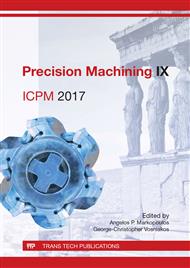[1]
Bilek O., Samek D., Suba O., Investigation of surface roughness while ball milling process; Key Engineering Materials 581 (2014) 335-340.
DOI: 10.4028/www.scientific.net/kem.581.335
Google Scholar
[2]
Fodor A, Boza P, Takács N., Machining of free-form surfaces in 3D and 5D; Proc. of Manufacturing 2012 Budapest (2012).
Google Scholar
[3]
Zebala W, Plaza M., Comparative study of 3- and 5-axis CNC centres for free-form machining of difficult-to-cut material; Int. J. Production Economics 158 (2014) 345–358.
DOI: 10.1016/j.ijpe.2014.08.006
Google Scholar
[4]
Wojciechowski S., Chwalczuk T., Twardowski P., Krolczyk, G. M., Modelling of cutter displacements during ball end milling of inclined surfaces. Archives of Civil and Mechanical Engineering 15(4) (2015) 798-805.
DOI: 10.1016/j.acme.2015.06.008
Google Scholar
[5]
Vopát T., Peterka J., Šimna V., Kuruc M., The influence of different types of copy milling on the surface roughness and tool life of end mills, Procedia Engineering, 100, (2015) 868-876.
DOI: 10.1016/j.proeng.2015.01.443
Google Scholar
[6]
Grandguillaume L., Lavernhe S., Quinsat Y., Tournier C., Mold manufacturing optimization: A global approach of milling and polishing processes, Procedia CIRP 31 (2015) 13-18.
DOI: 10.1016/j.procir.2015.03.035
Google Scholar
[7]
Vyboishchik A.V., Modelling Topology of Freeform Surfaces with Ball-end Milling, Procedia Engineering 150 (2016) 761-767.
DOI: 10.1016/j.proeng.2016.07.103
Google Scholar
[8]
Kundrák J., Felhő Cs., 3D Roughness Parameters of Surfaces Face Milled by Special Tools, Manufacturing technology 16: (3) (2016) 532-538.
DOI: 10.21062/ujep/x.2016/a/1213-2489/mt/16/3/532
Google Scholar
[9]
Beňo J., Manková I, Ižol P, Vrabel' M., An approach to the evaluation of multivariate data during ball end milling free-form surface fragments, Measurement 84 (2016) 7-20.
DOI: 10.1016/j.measurement.2016.01.043
Google Scholar
[10]
Matras A., Kowalczyk R., Analysis of machining accuracy during free form surface milling simulation for different milling strategies, Symposium on Photonics Applications in Astronomy, Communications, Industry and High-Energy Physics Experiments. International Society for Optics and Photonics (2014).
DOI: 10.1117/12.2075081
Google Scholar
[11]
Mikó B., Beno J., Mankova I., Experimental Verification of Cusp Heights when 3D Milling Rounded Surfaces; Acta Polytechnica Hungarica 9: 6 (2012) 101-116.
DOI: 10.12700/aph.9.6.2012.6.7
Google Scholar
[12]
Mikó B., Baranyai G.: The effect of milling direction to surface quality when free form surface finishing; Development in machining technology Vol. 5 Cracow University of Technology, Cracow (2015) 62-76.
Google Scholar


